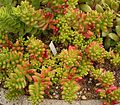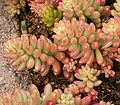Sedum rubrotinctum
| Sedum rubrotinctum subsp. var. | Jelly Bean Plant, Pork and Beans | |||||||||||||||||||||||||||||||||||||||||||||||||||||||
|---|---|---|---|---|---|---|---|---|---|---|---|---|---|---|---|---|---|---|---|---|---|---|---|---|---|---|---|---|---|---|---|---|---|---|---|---|---|---|---|---|---|---|---|---|---|---|---|---|---|---|---|---|---|---|---|---|

|
|
| ||||||||||||||||||||||||||||||||||||||||||||||||||||||
| ||||||||||||||||||||||||||||||||||||||||||||||||||||||||
Sedum rubrotinctum, commonly known as the Jelly Bean Plant, or Pork and Beans, is a species of Sedum from the Crassulaceae family of plants. Nicknamed for its short leaves that resemble jelly beans, especially when taking on a protective hue.[1] The plant was named officially as a distinct species in 1948. It is a succulent plant originating in Mexico, that is grown very easily and tolerates all types of soil except for those that are poorly drained. It grows very well in summer, but can take variations in climate although it is not frost-tolerant.
The leaves of this plant change colour from green to red during the summer months as a protective adaptation, and sprout bright yellow flowers from between the leaves in mid-spring.
Cultivation
Propagation
New plants may be grown from leaves (or beans) that drop off or are separated from the stem and laid on the soil.
Pests and diseases
Varieties
- Sedum rubrotinctum cv. 'Aurora' - whiter and pinker rather than green and red.
Gallery
References
- ↑ Cite error: Invalid
<ref>tag; no text was provided for refs namedBackyard_Gardener
External links
- w:Sedum rubrotinctum. Some of the material on this page may be from Wikipedia, under the Creative Commons license.
- Sedum rubrotinctum QR Code (Size 50, 100, 200, 500)




